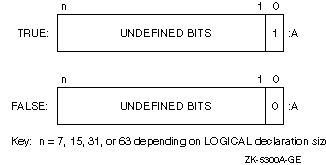Logical data lengths can be 1, 2, 4, or 8 bytes in length.
The default data size used for a LOGICAL data declaration is LOGICAL(4) (same as LOGICAL(KIND=4)), unless -integer-size 16 or -integer-size 64 (Linux OS and Mac OS X) or /integer-size:16 or /integer-size:64 (Windows OS) was specified.
To improve performance on systems using Intel® 64 architecture and IA-64 architecture, use LOGICAL(4) (or LOGICAL(8)) rather than LOGICAL(2) or LOGICAL(1). On systems using IA-32 architecture, use LOGICAL(4) rather than LOGICAL(8), LOGICAL(2), or LOGICAL(1).
LOGICAL(KIND=1) values are stored in 1 byte. In addition to having logical values .TRUE. and .FALSE., LOGICAL(1) data can also have values in the range -128 to 127. Logical variables can also be interpreted as integer data.
In addition to LOGICAL(1), logical values can also be stored in 2 (LOGICAL(2)), 4 (LOGICAL(4)), or 8 (LOGICAL(8)) contiguous bytes, starting on an arbitrary byte boundary.
If the -fpscomp nological (Linux OS and Mac OS X) or /fpscomp:nological (Windows OS) compiler option is set (the default), the low-order bit determines whether the logical value is true or false. Specify logical instead of nological for Microsoft* Fortran PowerStation logical values, where 0 (zero) is false and non-zero values are true.
LOGICAL(1), LOGICAL(2), LOGICAL(4), and LOGICAL(8) data representation (when nological is specified) appears below.
